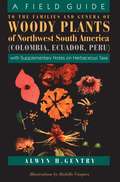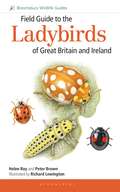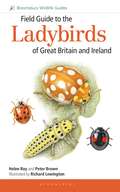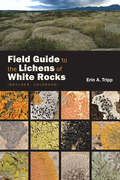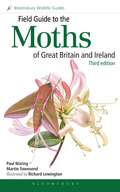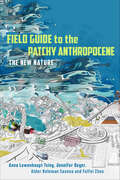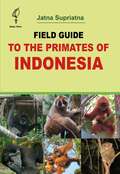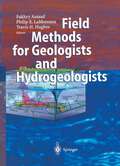- Table View
- List View
Field Guide to the Dragonflies and Damselflies of Great Britain and Ireland (Field Guides)
by Steve Brooks Steve ChamAll Great Britain and Ireland's resident and migrant dragonfly and damselfly species fully described and illustrated. Fully updated, revised and redesigned, this 2014 edition features full descriptions, ecological notes and distribution maps, as well as a general introduction and regional guide to the best places to watch dragonflies. The 2002 edition was shortlisted for the BP Natural World Book Prize.
Field Guide to the Dragonflies and Damselflies of Great Britain and Ireland (Field Guides)
by Steve Brooks Steve ChamAll Great Britain and Ireland's resident and migrant dragonfly and damselfly species fully described and illustrated. Fully updated, revised and redesigned, this 2014 edition features full descriptions, ecological notes and distribution maps, as well as a general introduction and regional guide to the best places to watch dragonflies. The 2002 edition was shortlisted for the BP Natural World Book Prize.
Field Guide to the Dragonflies of Britain and Europe: 2nd edition (Field Guides)
by K-D Dijkstra Asmus SchröterThe first edition of the Field Guide to the Dragonflies of Britain and Europe was a ground-breaking identification guide that led to an increase in Odonata recording across Europe. The second edition includes fully revised regional guides and identification texts, updated distribution maps and conservation statuses, illustrated accounts for five species that have been discovered in the region since the first edition, updated checklists and taxonomy, new photographs throughout, as well as an introduction to larvae identification. Each species is lavishly illustrated with artworks of males, females and variations, as well as close-ups of important characters.
Field Guide to the Dragonflies of Britain and Europe: 2nd edition (Field Guides)
by K-D Dijkstra Asmus SchröterThe first edition of the Field Guide to the Dragonflies of Britain and Europe was a ground-breaking identification guide that led to an increase in Odonata recording across Europe. The second edition includes fully revised regional guides and identification texts, updated distribution maps and conservation statuses, illustrated accounts for five species that have been discovered in the region since the first edition, updated checklists and taxonomy, new photographs throughout, as well as an introduction to larvae identification. Each species is lavishly illustrated with artworks of males, females and variations, as well as close-ups of important characters.
A Field Guide to the Families and Genera of Woody Plants of Northwest South America: With Supplementary Notes on Herbaceous Taxa
by Alwyn H. GentryTo understand almost any part of the tropical rain forest's fabulously complex web of life, one must first learn to identify a bewildering array of plants. Alwyn Gentry's landmark book, completed just before his tragic death in 1993, is the only field guide to the nearly 250 families of woody plants in the most species-rich region of South America. As a consummate field researcher, Gentry designed this guide to be not just comprehensive, but also easy to use in rigorous field conditions. Unlike many field guides, which rely for their identifications on flowers and fruits that are only present during certain seasons, Gentry's book focuses on characters such as bark, leaves, and odor that are present year-round. His guide is filled with clear illustrations, step-by-step keys to identification, and a wealth of previously unpublished data. All biologists, wildlife managers, conservationists, and government officials concerned with the tropical rain forests will need and use this field guide. Alwyn Gentry was one of the world's foremost experts on the biology of tropical plants. He was senior curator at the Missouri Botanical Garden, and was a member of Conservation International's interdisciplinary Rapid Assessment Program (RAP) team, which inventories the biodiversity of the most threatened tropical areas. From 1967 to 1993 he collected more than 80,000 plant specimens, many of them new to science.
Field Guide to the Forest Trees of Uganda: For Identification and Conservation
by James Kalema Professor Alan HamiltonThis book is a guide for the identification of the indigenous forest trees of Uganda. It will be useful for those who wish to contribute towards the conservation of the forests or to plant indigenous trees. Information is provided on how to propagate and cultivate about 80 of the most valuable species. Indigenous trees provide numerous resources useful for welfare and development. They include many types of timber and non-timber forest products, such as craft materials, foods and medicines. The proximity of indigenous forest helps to moderate the local climate, making it more suitable for agriculture. Indigenous forests protect springs, therefore safeguarding water supplies more effectively than exotic trees such as pines and eucalyptus. All 450 known indigenous tree species from the forests are included. Both scientific and local names are provided, the latter in 21 languages. Local names facilitate access to knowledge and values traditionally attached to the species, useful when planning pathways of development firmly rooted in local culture. The book will be invaluable for botanists, foresters, rural development workers and members of the general public concerned about contributing to conservation and sustainable development in Uganda. Many of the species grow in neighbouring countries, so the book has relevance there too.
A Field Guide to the Geology of Western Ireland: The Birth and Death of an Ocean (Springer Geology)
by Paul D. RyanThis book contains a comprehensive field guide, including detailed itineraries and supporting data, to the Geology of Western Ireland, a classic site for world geology. It facilitates study into the rock record of the Neoproterozoic ‘birth’ to the Devonian ‘death’ of the Iapetus Ocean along the Laurentian (North American) margin. The enormous variety of lithologies and processes available for study in this spectacularly exposed region include: fluviatile to deep-sea sediments; layered ultramafic intrusions to reverse zoned granite batholiths; zeolite to eclogite facies metamorphic assemblages; continental rifting; subduction processes; island arc evolution; arc-continent collision; Andean margin development; and continent-continent collision. An introduction to the geology, that includes information relevant to the planning and execution of field trips in the region, is followed by nine chapters each providing the necessary background, field itineraries, exercises and points for debate, covering: the Laurentian basement and Neoproterozoic cover of North Mayo, Sligo, the Ox Mountains and Connemara; the metamorphic nappes and syn-orogenic intrusions of the Ordovician Grampian Orogeny; the Cambro-Ordovician subduction-accretion complex of Clew Bay; the obducted Ordovician fore-arc basin of South Mayo; the post-subduction flip late-Ordovician of South Connemara; the Silurian successor basins deformed during the final closure of the Iapetus Ocean; the late to post-orogenic Devonian sediments; the Devonian Granite batholiths ; and the post-orogenic Carboniferous cratonic sediments. Two final chapters summarise: the current tectonic interpretation of this region; areas for future research; and the extensive sources of geochemical and geophysical data.
Field Guide to the Ladybirds of Great Britain and Ireland (Field Guides)
by Helen Roy Dr Peter Brown Richard Lewington"A ground-breaking identification guide ... the perfect marriage of artistic excellence, deep knowledge and, dare I say it, of scientists' genuine affection." BRETT WESTWOODThis brand new illustrated field guide covers all 47 species of ladybird occurring in the British Isles in a handy and easy-to-use format. Twenty-seven species are colourful and conspicuous and easily recognised as ladybirds; the remaining species are more challenging, but the clear illustrations and up-to-date text in this guide will help to break down the identification barriers. A useful introduction provides an overview of ladybird ecology, tips on studying and recording, and suggested sites for finding ladybirds. The main part of the book comprises detailed species texts, covering field characters, food, habitats, suggested survey methods, ranges, conservation statuses and distribution trends. An illustrated at-a-glance identification guide and helpful pointers for differentiating similar-looking species are also included. With 102 colour photographs and 47 distribution maps, combined with Richard Lewington's peerless artwork, this is the definitive guide to one of our most cherished and charismatic insect groups.
Field Guide to the Ladybirds of Great Britain and Ireland (Field Guides)
by Helen Roy Peter Brown Richard Lewington"A ground-breaking identification guide ... the perfect marriage of artistic excellence, deep knowledge and, dare I say it, of scientists' genuine affection." BRETT WESTWOODThis brand new illustrated field guide covers all 47 species of ladybird occurring in the British Isles in a handy and easy-to-use format. Twenty-seven species are colourful and conspicuous and easily recognised as ladybirds; the remaining species are more challenging, but the clear illustrations and up-to-date text in this guide will help to break down the identification barriers. A useful introduction provides an overview of ladybird ecology, tips on studying and recording, and suggested sites for finding ladybirds. The main part of the book comprises detailed species texts, covering field characters, food, habitats, suggested survey methods, ranges, conservation statuses and distribution trends. An illustrated at-a-glance identification guide and helpful pointers for differentiating similar-looking species are also included. With 102 colour photographs and 47 distribution maps, combined with Richard Lewington's peerless artwork, this is the definitive guide to one of our most cherished and charismatic insect groups.
Field Guide to the Lichens of White Rocks: (Boulder, Colorado)
by Erin TrippField Guide to the Lichens of White Rocks is a careful examination of the lichens that occur at the ecologically important and lichenologically rich urban outcropping of Fox Hills sandstone known as White Rocks Nature Preserve, located in Boulder County, Colorado. This extensively illustrated field guide presents detailed information on the macroscopic and microscopic features needed to identify species, as well as extensive notes on how to differentiate closely related lichens—both those present at White Rocks and those likely to be found elsewhere in western North America. This guide is one of the only complete lichen inventories of a sandstone formation in North America and covers all constituents including the crustose microlichen biota, traditionally excluded from other inventories. A short introduction and glossary equip the reader with basic information on lichen morphology, reproduction, and ecology. Visitors to White Rocks Nature Preserve must schedule staff-led public tours or set up sponsored research projects through the City of Boulder Open Space and Mountain Parks, and there are many other outcroppings of Fox Hills sandstone across the West, making Field Guide to the Lichens of White Rocks a significant resource for anyone interested in this unique environment. This accessible, user-friendly guide will also be valuable to naturalists and lichenologists around the world as well as educators, conservationists, and land managers concerned with the growing significance of open spaces and other protected urban areas throughout North America. The University Press of Colorado gratefully acknowledges the generous support of the University of Colorado Natural History Museum, City of Boulder Parks & Open Spaces, and the Colorado Native Plant Society board and members toward the publication of this book.
Field Guide to the Moths of Great Britain and Ireland: Third Edition (Field Guides)
by Paul Waring Martin Townsend Richard LewingtonThis latest edition of the Field Guide to the Moths of Great Britain and Ireland has been fully revised, updated and restructured, bringing it in line with the latest thinking in taxonomy. Moths are illustrated in their natural resting postures, and there are also paintings of different forms, underwings and other details to help with identification. New descriptions and illustrations have been included for species that have been newly recorded in Britain and Ireland since the last edition of the guide was published. The text descriptions of all other species – covering field characters and similar species, flight season, life cycle, larval foodplants, and habitat – have been revised and updated where necessary, and particular attention has been paid to updating the distribution information, which is now supported by maps. The revised general introduction explains how the methods of identifying and recording moths have evolved over recent years with the advent of new technologies and as a result of data analysis.
Field Guide to the Moths of Great Britain and Ireland: Third Edition (Field Guides)
by Paul Waring Martin Townsend Richard LewingtonThis latest edition of the Field Guide to the Moths of Great Britain and Ireland has been fully revised, updated and restructured, bringing it in line with the latest thinking in taxonomy. Moths are illustrated in their natural resting postures, and there are also paintings of different forms, underwings and other details to help with identification. New descriptions and illustrations have been included for species that have been newly recorded in Britain and Ireland since the last edition of the guide was published. The text descriptions of all other species – covering field characters and similar species, flight season, life cycle, larval foodplants, and habitat – have been revised and updated where necessary, and particular attention has been paid to updating the distribution information, which is now supported by maps. The revised general introduction explains how the methods of identifying and recording moths have evolved over recent years with the advent of new technologies and as a result of data analysis.
A Field Guide to the Neogene Sedimentary Basins of the Almeria Province, SE Spain (International Association Of Sedimentologists Series #13)
by Jose M. Martin Anne E. Mather Adrian M. Harvey Juan C. BragaThe Almería Province of SE Spain, a semi-arid, tectonically active region, is the focus of a wide range of scientific teaching and research in the earth sciences by universities and associated bodies from around the world. This field guide provides an up-to-date and integrated approach to the geology and geomorphology of Almería Province, compiled by active scientific researchers in the region. The guide assumes a basic knowledge of geology and geomorphology and will be of interest to earth scientists at all levels from the keen amateur through to undergraduate/postgraduate students and academics visiting the region. The guide provides general background on the area, followed by a selection of specialized trips that progressively explore the structure and development of the basins, the shallow marine sedimentation, the continental sedimentation and finally the uplift, dissection and geomorphic evolution of the sedimentary basins. This is the first widely published field guide on the Almería Province and it is unique in both its coverage and integrated earth science approach, providing valuable support for both teaching and research in the region. If you are a member of the International Association of Sedimentologists, for purchasing details, please see: http://www.iasnet.org/publications/details.asp?code=FG1
Field Guide to the Patchy Anthropocene: The New Nature
by Anna Lowenhaupt Tsing Jennifer Deger Alder Keleman Saxena Feifei ZhouNature has gone feral. How can we re-attune ourselves to the new nature? A field guide can help. While the global scientific community recently made headlines by ruling the Anthropocene—an era many date to the Industrial Revolution when human action truly began to transform the planet—did not qualify for a geological epoch quite yet, understanding the nature of human transformation of the Earth is more important than ever. The effects of human activity are global in scope, but take shape within distinct social and ecological "patches," discontinuous regions within which the key actors may not be human, but the plants, animals, fungi, viruses, plastics, and chemicals creating our new world. Field Guide to the Patchy Anthropocene takes stock of our current planetary crisis, leading readers through a series of sites, thought experiments, and genre-stretching descriptive practices to nurture a revitalized natural history. Field guides teach us how to notice, name, and so better appreciate more-than-human worlds. They hone our powers of observation and teach us to see the world anew. Field-based observations and place-based knowledge cultivation—getting up-close and personal with patchy dynamics—are vital to truly grapple with the ecological challenges and the historical conjunctures that are bringing us to multiple catastrophic tipping points. How has commercial agriculture runoff given rise to comb jellies in the Black Sea? What role did the Atlantic slave trade play in the worldwide spread of virus-carrying mosquitoes? How did the green revolution transform the brown planthopper into a superpredator in Philippine rice fields? Questions like these open up new ways of understanding, and ways of living through, the epoch that human activity has ushered in. This Field Guide shifts attention away from knowledge extractive practices of globalization to encourage skilled observers of many stripes to pursue their commitments to place, social justice, and multispecies community. It is through attention to the beings, places, ecologies, and histories of the Anthropocene that we can reignite curiosity, wonder, and care for our damaged planet.
Field Guide to the Patchy Anthropocene: The New Nature
by Anna Lowenhaupt Tsing Jennifer Deger Alder Keleman Saxena Feifei ZhouNature has gone feral. How can we re-attune ourselves to the new nature? A field guide can help. While the global scientific community recently made headlines by ruling the Anthropocene—an era many date to the Industrial Revolution when human action truly began to transform the planet—did not qualify for a geological epoch quite yet, understanding the nature of human transformation of the Earth is more important than ever. The effects of human activity are global in scope, but take shape within distinct social and ecological "patches," discontinuous regions within which the key actors may not be human, but the plants, animals, fungi, viruses, plastics, and chemicals creating our new world. Field Guide to the Patchy Anthropocene takes stock of our current planetary crisis, leading readers through a series of sites, thought experiments, and genre-stretching descriptive practices to nurture a revitalized natural history. Field guides teach us how to notice, name, and so better appreciate more-than-human worlds. They hone our powers of observation and teach us to see the world anew. Field-based observations and place-based knowledge cultivation—getting up-close and personal with patchy dynamics—are vital to truly grapple with the ecological challenges and the historical conjunctures that are bringing us to multiple catastrophic tipping points. How has commercial agriculture runoff given rise to comb jellies in the Black Sea? What role did the Atlantic slave trade play in the worldwide spread of virus-carrying mosquitoes? How did the green revolution transform the brown planthopper into a superpredator in Philippine rice fields? Questions like these open up new ways of understanding, and ways of living through, the epoch that human activity has ushered in. This Field Guide shifts attention away from knowledge extractive practices of globalization to encourage skilled observers of many stripes to pursue their commitments to place, social justice, and multispecies community. It is through attention to the beings, places, ecologies, and histories of the Anthropocene that we can reignite curiosity, wonder, and care for our damaged planet.
Field Guide to the Primates of Indonesia
by Jatna SupriatnaThis primate field guide can be used to refer to information on each species, or it can be used to find which species exist on each island, as shown at the back of the book. A list of primates in Indonesia is provided with local, English, and scientific names. Once the name is identified the user can go to the description of the genus and species. Also given is the conservation status of each species except for the most recently described, whose status is not yet known. The information on each species' natural history, behavior, ecology, and where to see it in parks and/or forested areas outside parks is included. Field Guide to the Primates of Indonesia primate drawings are by Stephen Nash and photographs were donated by many of the author's friends from Indonesia and abroad.
Field Hydrogeology: A Guide for Site Investigations and Report Preparation, Second Edition
by John E. MooreIn recent years, the focus in hydrogeologic investigations has expanded to include aquifer sustainability as part of resource evaluations. While there are other books on the subject, Field Hydrogeology: A Guide for Site Investigations and Report Preparation provides the first integrated presentation of the American Society of Testing Materials (AST
Field Informatics: Kyoto University Field Informatics Research Group
by Toru IshidaHere we use the term "field" to refer to a sphere of practical operation, and correspondingly the term "field informatics" describes informatics tools and methodologies that arise in the field. The components of field informatics are description, prediction, design and transfer, and the methods for those components vary widely. For example, we consider the social goal of revitalizing a mountainous area experiencing depopulation and we show how the tools and methodologies of field informatics may be used to describe such situations using remote sensing, biologging, human sensing and ethnography; the effects of various solutions can be predicted using system dynamics and multiagent simulations; the solutions can be designed using inclusive design or participatory design methods; and finally the experience gained can be transferred using case writing and outreach communication.The authors are specialists in diverse areas such as informatics, engineering, agriculture, sociology and pedagogy, and their areas of interest range from environment conservation to social education for international cooperation. They have a particular focus on the environment in southeast Asia and related topics such as large-scale traffic simulations, participatory workshops, inclusive design workshops, distance learning, and intercultural collaboration.This book targets graduate students seeking tools and methodologies for natural observation, field workers engaged in social participation, and researchers and engineers pursuing innovation. The techniques described in the book could also be exploited by government officials to form consensus and develop activities or by non-profit organizations to undertake more effective social programs.
Field Margin Vegetation and Socio-Ecological Environment: Structural, Functional and Spatio-temporal Dynamics in Rural-urban Interface of Bengaluru (Environmental Science and Engineering)
by Sunil Nautiyal Mrinalini Goswami Puneeth ShivakumarThis book has been produced as a part of the project ‘Social-Ecological Systems at the Indian Rural-Urban Interface: Functions, Scales, and Dynamics of Transition’. It addresses transition processes in agriculture and society triggered by urbanization, focusing on Bengaluru as an example of a rapidly growing megacity in India. Adopting a holistic, multidisciplinary approach embedded within a social-ecological systems research framework, it explores how the physical and socio-economic landscapes have led to changes in economic priorities, which have overpowered ecological and traditional priorities with regard to ecosystem governance. Allowing readers to gain a deeper understanding of this unexplored dimension of socio-ecological systems, this book is a valuable resource for international researchers, scholars and master’s students in the field of environmental science, socio-ecology, forestry and agriculture.
Field Measurements for Forest Carbon Monitoring: A Landscape-Scale Approach
by Coeli M. HooverIn the summer of 2003, a workshop was held in Portsmouth, NH, to discuss land measurement techniques for the North American Carbon Program. Over 40 sci- tists representing government agencies, academia and nonprofit research organi- tions located in Canada, the US and Mexico participated. During the course of the workshop a number of topics were discussed, with an emphasis on the following: • The need for an intermediate tier of carbon measurements. This level of study would be more extensive than state-level inventories of the US Forest Service Forest Inventory and Analysis Program, but less detailed than intensive ecos- tem studies sites such as those in Long Term Ecological Research network. This tier would ideally provide a basis to link and scale remote sensing measurements and inventory data, and supply data required to parameterize existing models (see Wofsy and Harriss 2002, Denning et al. 2005). • The design criteria that such a network of sites should meet. The network and s- pling design should be standardized, but flexible enough to be applied across North America. The design also needs to be efficient enough to be implemented without the need for large field crews, yet robust enough to provide useful information. Finally, the spatial scale must permit easy linkage to remotely sensed data. • The key variables that should be measured at each site, and the frequency of measurement.
Field Methods for Geologists and Hydrogeologists
by Fakhry A. Assaad James W. LaMoreaux Travis HughesFrom the reviews: "...is a "must" for serious field novices, and for seasoned middle-career and senior practitioners in hydrogeology, mainly those people who answer a calling to offer honest and accurate hydrogeological approximations and findings. Any engineering geologist or groundwater geologist who claims capability as a "Hydrogeologist" should own this book and submit it to highlighting and page tabbing. Of course, the same goes for those who practice in karst terranes, as author LaMoreaux is one of the pioneers in this field, worldwide..." (Allen W. Hatheway)
Field Methods for Petroleum Geologists: A Guide to Computerized Lithostratigraphic Correlation Charts Case Study: Northern Africa
by Fakhry A. AssaadProvides an introduction to petroleum exploration methods, referring to both geophysical and geochemical techniques and the logistics of various drilling techniques and well logging methods for oil and gas exploration. The second part of the book focuses on using these methods for petroleum exploration within the context of northern Africa. The geology of northern Africa is described and computerized lithographic correlation charts are presented and applied to petroleum exploration targets from the region.
Field Methods in Marine Science: From Measurements to Models
by Scott MilroyField Methods in Marine Science: From Measurements to Models is an authoritative guide of the methods most appropriate for field research within the marine sciences, from experimental design to data analysis. Written for upper-level undergraduate and graduate students as well as early-career researchers, this textbook also serves as an accessible introduction to the concepts and practice of modeling marine system dynamics. This textbook trains the next generation of field scientists to move beyond the classic methods of data collection and statistical analysis to contemporary methods of numerical modeling; to pursue the assimilation and synthesis of information, not the mere recording of data. Boxes and side bars highlight important questions, interesting facts, relevant examples, and research techniques that supplement the text. Students and researchers alike will find the thorough appendices useful as a way of expanding comprehension of fundamental concepts.
Field Methods in Marine Science: From Measurements to Models
by Scott MilroyField Methods in Marine Science: From Measurements to Models is an authoritative guide of the methods most appropriate for field research within the marine sciences, from experimental design to data analysis. Written for upper-level undergraduate and graduate students as well as early-career researchers, this textbook also serves as an accessible introduction to the concepts and practice of modeling marine system dynamics. This textbook trains the next generation of field scientists to move beyond the classic methods of data collection and statistical analysis to contemporary methods of numerical modeling; to pursue the assimilation and synthesis of information, not the mere recording of data. Boxes and side bars highlight important questions, interesting facts, relevant examples, and research techniques that supplement the text. Students and researchers alike will find the thorough appendices useful as a way of expanding comprehension of fundamental concepts.
Field Notes from a Catastrophe: Climate Change - Is Time Running Out?
by Elizabeth KolbertThe world has known about global warming since the late 1970s, yet little has been done to halt it. The threat, if we fail, is nothing less than catastrophe - the flooding of coastal communities, the extinction of species and entry into a climate regime of which humans have no experience. Exploring the relationship between what we know and what we refuse to know, Elizabeth Kolbert takes us on an urgent journey from the Arctic to Central America, interviewing researchers, environmentalists and traditional Inuits whose lives have already been dramatically altered by climate change.



